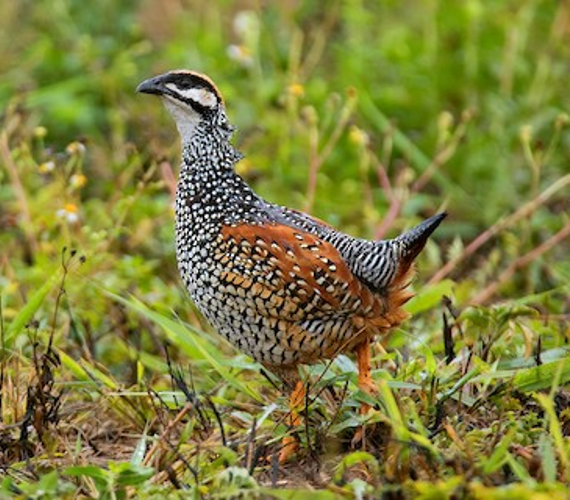Birdfinding.info ⇒ Shy and difficult to see except when males call from prominent perches. Uncommon and local in the northern parts of its range, but somewhat more common southward, mainly from central Myanmar through western and central Thailand and most of Cambodia into southern Vietnam. Sites where it is reliably present include Mae Hia Agricultural College in Chiang Mai, Thailand, the Tmatboey Ecolodge in northern Cambodia, and Tai Mo Shan Country Park in Hong Kong. Near Bangkok, it can sometimes be found at Bang Phra, the Saraburi Campus of Chulalongkorn University, and in Khao Yai National Park.
Chinese Francolin
Francolinus pintadeanus
Southeastern Asia, where it occurs in grassy scrub, open woodlands, and adjacent fields, usually on or near hillsides with rocky outcroppings or analogous features.
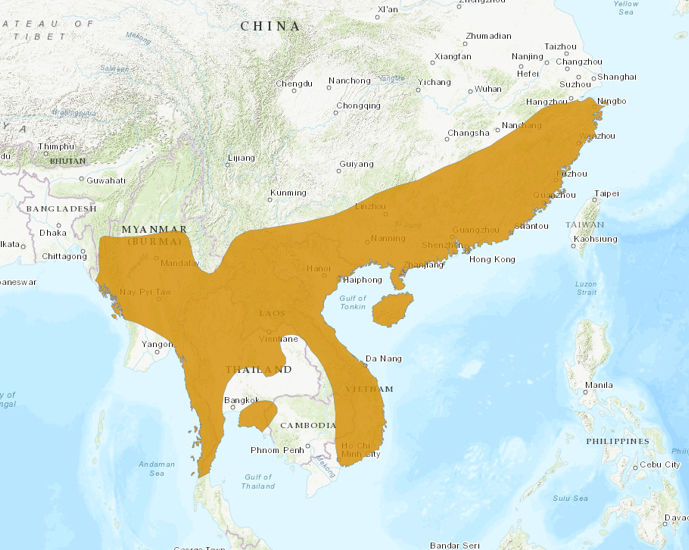
Approximate distribution of Chinese Francolin. © BirdLife International 2016
From easternmost India (Manipur) east along the southern tier of Chinese provinces to Fujian, and south nearly throughout Myanmar and the Indochinese Peninsula to the northern Malay Peninsula and southern Vietnam.
Introductions have been attempted in the Philippines and Mauritius, but apparently without lasting success.
Identification
Distinctive and unlikely to be confused if seen clearly. Extensively spotted and barred black-and-white, with a white cheek and throat, a black mask and whisker stripe, a rusty or buffy visor, a buffy wash on the flanks, and rufous patches on the wings, scapulars, and vent.
The sexes are mostly similar but females are less crisply patterned than males: with less extensive spots and bars, and generally suffused with pale brown.

Chinese Francolin, male. (Pu Plu, Phetchaburi, Thailand; April 9, 2018.) © Ayuwat Jearwattanakanok
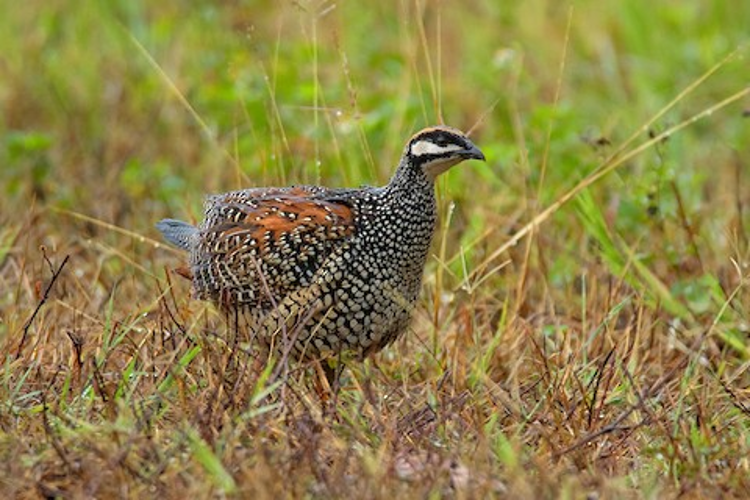
Chinese Francolin, male. (Mae Hia Agricultural College, Chiang Mai, Thailand; April 17, 2017.) © Ayuwat Jearwattanakanok
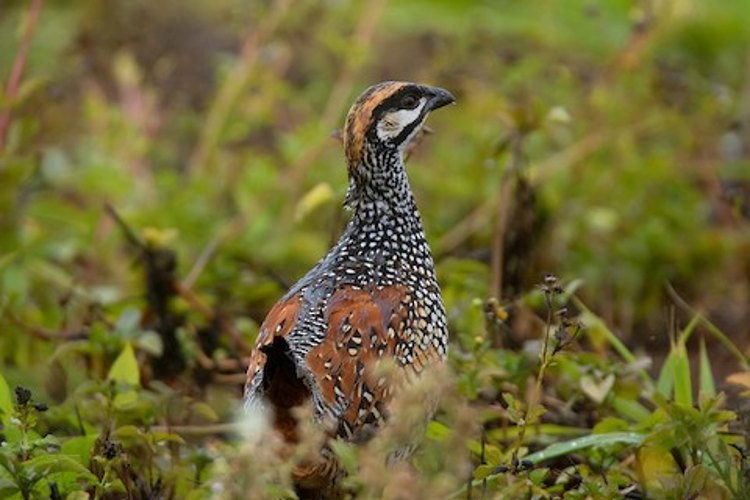
Chinese Francolin, male. (Mae Hia Agricultural College, Chiang Mai, Thailand; April 17, 2017.) © Ayuwat Jearwattanakanok
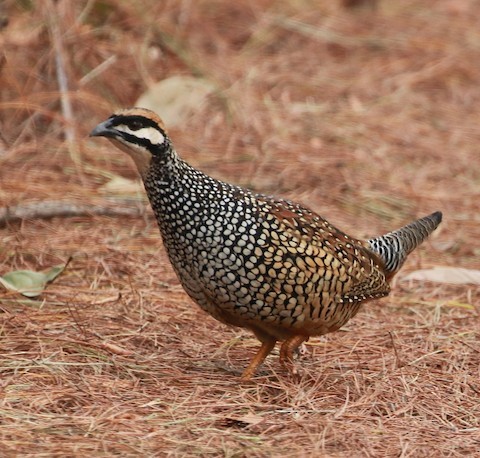
Chinese Francolin, male. (Doi Pha Hom Pok National Park, Chiang Mai, Thailand; March 13, 2017.) © David Stejskal

Chinese Francolin, male. (Western Siem Pang Wildlife Sanctuary, Stueng Traeng, Cambodia; March 22, 2017.) © Ayuwat Jearwattanakanok
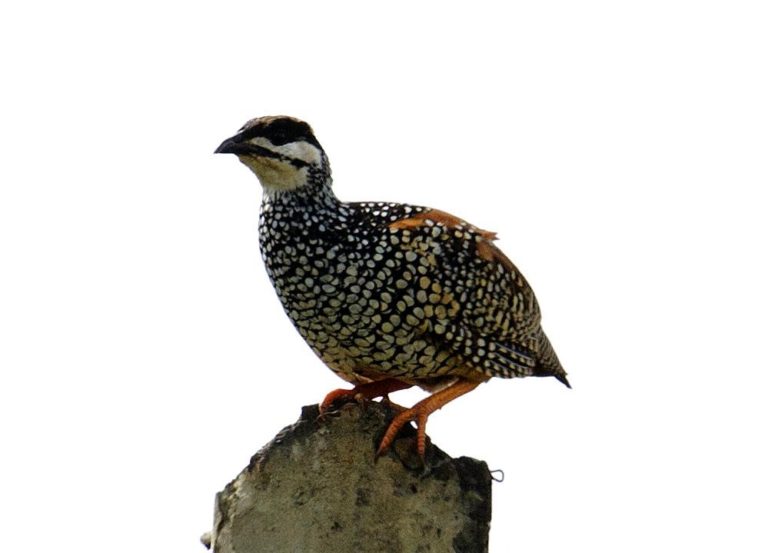
Chinese Francolin, male. (Khao Yai National Park, Nakhon Nayok, Thailand; July 5, 2015.) © Bird Soong
Notes
Polytypic species consisting of two recognized subspecies.
References
BirdLife International 2016. Francolinus pintadeanus. The IUCN Red List of Threatened Species 2016: e.T22678725A92785250. https://dx.doi.org/10.2305/IUCN.UK.2016-3.RLTS.T22678725A92785250.en. (Accessed March 9, 2020.)
Brazil, M. 2009. Birds of East Asia. Princeton University Press, Princeton, N.J.
eBird. 2020. eBird: An online database of bird distribution and abundance. Cornell Lab of Ornithology, Ithaca, N.Y. http://www.ebird.org. (Accessed March 9, 2020.)
Madge, S., and P.J.K. McGowan. 2002. Pheasants, Partridges, and Grouse: A Guide to the Pheasants, Partridges, Quails, Grouse, Guineafowl, Buttonquails, and Sandgrouse of the World. Princeton University Press, Princeton, N.J.
McGowan, P.J.K., and G.M. Kirwan. 2020. Chinese Francolin (Francolinus pintadeanus). In: del Hoyo, J., Elliott, A., Sargatal, J., Christie, D.A. & de Juana, E. (eds.). Handbook of the Birds of the World Alive. Lynx Edicions, Barcelona. https://www.hbw.com/node/53388. (Accessed March 9, 2020.)
Robson, C. 2002. Birds of Thailand. Princeton University Press, Princeton, N.J.
